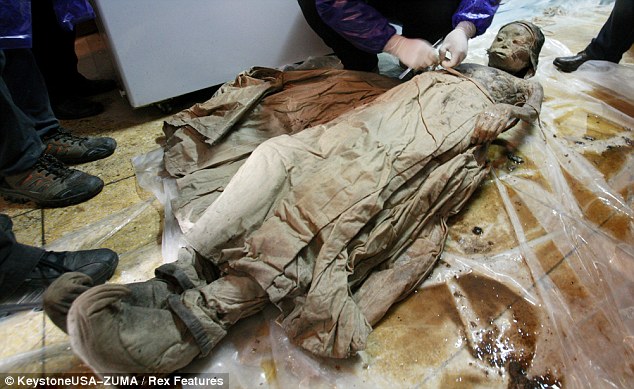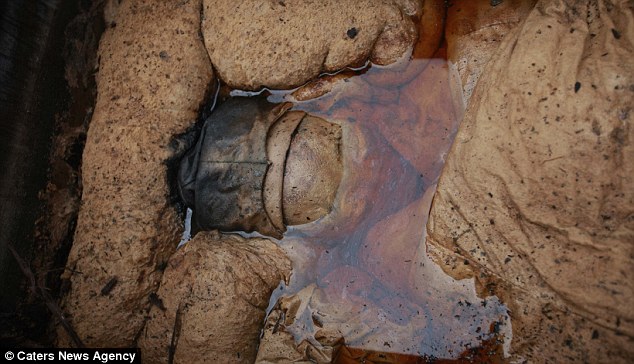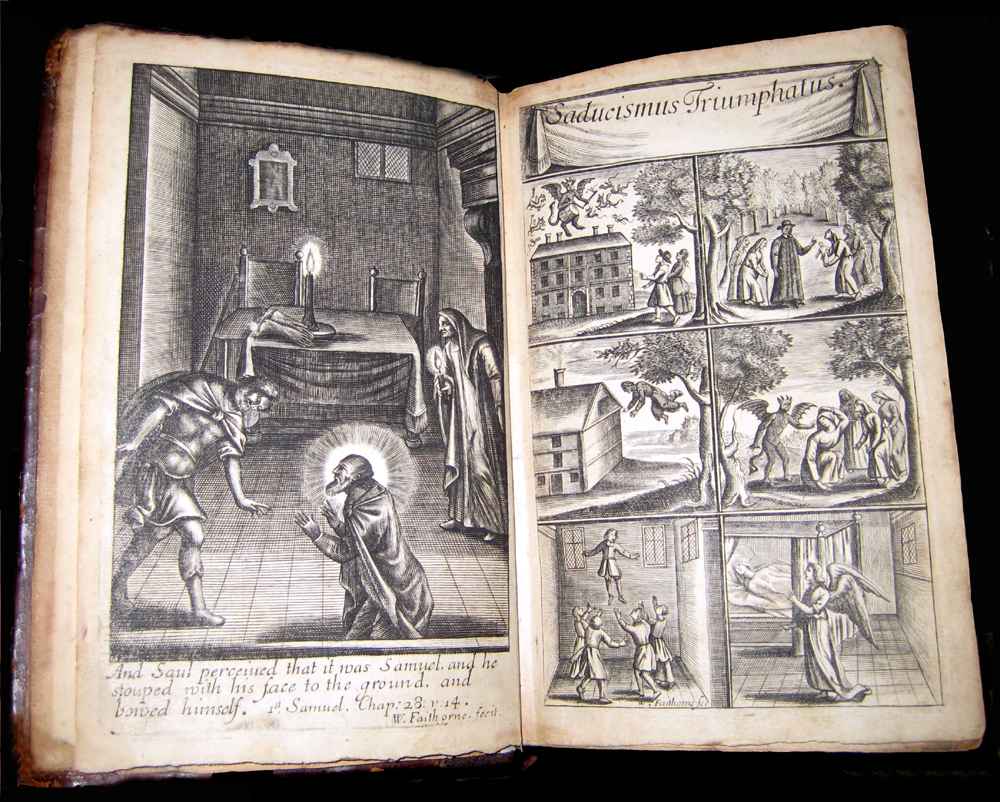# Eyebrows still intact highlighting amazing level of preservation
# Mummy believed to be a high-ranking member of the Ming Dynasty
# Wearing silk and cotton, she's the first major discovery in years in the area
These incredible pictures show a 700-year-old mummy, which was discovered by chance - by road workers - in excellent condition in eastern China.

The woman, discovered two metres below the surface in a wooden tomb, was wearing a Ming Dynasty dress and is thought to have been at a high-ranking level
The corpse of the high-ranking woman believed to be from the Ming Dynasty - the ruling power in China between 1368 and 1644 - was stumbled across by a team who were looking to expand a street.
And the mummy, which was found in the city of Taizhou, in the Jiangsu Province, along with two other wooden tombs, offers a fascinating insight into life as it was back then.

Immersed: The mummy was found by road workers, and had been preserved in a brown liquid
Discovered two metres below the road surface, the woman's features - from her head to her shoes - have retained their original condition, and have hardly deteriorated.
When the discovery was made by the road workers, late last month, Chinese archaeologists, from the nearby Museum of Taizhou, were called into excavate the area, the state agency Xinhua News reported.
They were surprised by the remarkably good condition of the woman's skin, hair, eyelashes and face. It was as though she had only recently died.
Read more at 700 year old mummy found

The incident occurred on May 20, 1967, in an area near Falcon Lake, Manitoba, Canada, approximately 75 kilometres north of the American border in the rocky edge of the great Canadian Shield. Falcon Lake is a resort town at the southern boundary of Whiteshell Provincial Park. The park is largely uninhabited wilderness, known for various mineral deposits, and several small mines were established in the surrounding region. Stefan Michalak was an amateur geologist and had worked the area many times. Some prospectors had found several quartz veins nearby that were associated with silver deposits, and Michalak had even staked a few claims himself. On May 19, 1967, he traveled from his home in Winnipeg to Falcon Lake, where he spent the night in a motel on the Trans-Canada Highway.
The Encounter
Stefan Michalak left his motel at 5:30 that morning and headed north into the bush. By 9:00 a.m., traveling under a bright, cloudless sky, he had found a quartz vein near a marshy area, close to a small stream. At 11:00 a.m. he had lunch, then went back to his examination of the quartz formation. At 12:15 p.m., with the sun high and clouds gathering in the west, Michalak was startled by the cackling of some geese, who were obviously disturbed by something. He looked up and was surprised to see two cigar-shaped objects with "bumps" on them, an estimated forty-five degrees in altitude, descending and glowing red. As they approached, they appeared disc-shaped.
The furthest of the pair stopped in mid-flight, and the other drew nearer and landed on a large, flat rock which was later determined to be about 160 feet away. The one in the air hovered for a short while, then later departed, changing from red to orange to grey as it flew into the west, where it disappeared behind the clouds. Focusing his attention to the object on the ground, Michalak saw that it, too, was turning from red to grey, until it finally was the colour of "hot stainless steel," surrounded by a golden-hued glow. As he observed the object, he knelt beside a rock where he had been chipping at the quartz. He had been wearing welding goggles to protect his eyes from flying rock fragments. The goggles proved to be very useful, as brilliant light shone from openings in the object, blinding him and creating red afterimages in his eyes.
Read more at Falcon Lake UFO Case
LITTLE Supatra Sasuphan is celebrating after being named the World's Hairiest Girl.
A young girl who for years suffered nasty nicknames like "monkey face" and "wolf girl" finally has a reason to smile about a rare medical condition that causes excessive hair growth on her face.

Supatra Sasuphan, 11, earned the Guinness World Record for hairiest girl last year and in a new interview with Britain's Daily Mail the "delighted" Thai girl reveals winning the title changed her life for the better.
"I'm very happy to be in the Guinness World Records! A lot of people have to do a lot to get in," she told the Mail. "All I did was answer a few questions and then they gave it to me."

Supatra - whose face, ears, limbs, back and even eyelids are covered in thick hair - snagged the title, recorded as "hairiest teenager" on the Guinness website, after an evaluation in Italy in March 2010
She said winning the title has erased the shame of her unusual condition and even boosted her popularity at school.
"There were a few people who used to tease me and call me monkey face, but they don't do it anymore," she said.
Supatra was born with Ambras syndrome – a congenital disease triggered by a chromosome mutation – that has been documented in fewer than 50 people across the globe, according to an article by dermatologists at the National Naval Center.

For now, there is no cure for the condition and no hair removal methods have been successful for Supatra, who aside from her appearance is just like any other preteen: She loves dancing, listening to music and watching cartoons.
Doctors tried several rounds of laser hair removal treatments on Supatra when she was a toddler, but her mane grew back each time.
Read more at Worlds Hairiest Girl

The story is considered by some to be an early account of the activity of a poltergeist, a mischievous spirit that makes noises unexplainable except by supernatural causes. John Mompesson, a justice of the peace, had brought before him an ex-drummer in Cromwell’s army, who had been demanding money of the bailiff by virtue of a suspicious pass. The bailiff had believed the pass to be counterfeit, and Mompesson, who was familiar with the handwriting of the gentleman who had allegedly signed the note, immediately declared the paper to be a forgery. The drummer, whose name was Drury, begged Mompesson to check his story with Colonel Ayliff of Gretenham. The colonel would vouch for his integrity, the drummer insisted. Mompesson was swayed by the drummer’s pleas that he not be put into jail, but he told the man that he would confiscate his drum until he had checked out his story. Drury demanded that his drum be returned, but Mompesson told him to be on his way and to give thanks for his own freedom. Mompesson had the drum sent to his house for safekeeping, then left on a business trip to London.
Upon his return, his wife informed him that the household had been terrorized by strange noises in the night. She could only accredit the sounds to burglars trying to break into the house. On the third night of his return, Mompesson was brought to his feet by a loud knocking that seemed to be coming from a side door. With a pistol in one hand and another in his belt, Mompesson opened the door. No one was there, but now the knocking had begun at another door. He flung that one open, too, and finding no one there, walked around the outside of the house in search of the culprit. He found no one on his search, nor could he account for the hollow drumming that sounded on the roof when he went back to bed. From that night on, the drumming came always just after the Mompessons had gone to bed. It made no difference whether they retired early or late, the invisible drummer was ever prepared to tap them an annoying lullaby.
Read more at The Phantom Drummer of Tedworth

Yuurei, is the soul(reikon) of someone wandering around seeking revenge. This is because the person died either by murder, slain in battle, suicide, or the person hasn’t been given an appropriate funeral.
Often said to be haunted by the ghost of Okiku. She is supposed to rise from the well at night and count to nine before shrieking and returning to the well. The ghost story of Okiku, an unfortunate servant maid, is one of the best known and was transformed into a Kabuki play and numerous novels.
Some stories, however, locate the haunted well in the Canadian embassy in Tokyo's garden.
There are different versions of the ghost story of Okiku. What they all have in common is the description of her ghost coming out of the well and counting from one to nine and then breaking out into a heart-rendering sobbing.
In another version, Okiku really breaks a plate and is killed by her master and her corpse is thrown into the well.
In yet another version, it is the wife of Aoyama, who breaks the plate. To hide her guilt, she throws the broken plate into the well and accuses Okiku of having it stolen. In this version she is also killed by her master for punishment and thrown into the well.
There is also an alternate version for the end of the story. To stop the nightly sobbing, a friend of the family of Aoyama is hired. He is hiding at the well during the night and after Okiku had counted from one to nine, he is stepping forward shouting loudly "ten". From then on the ghost of Okiku was never seen again.
In Japanese culture, ghosts take on many different forms. Yuurei are ghosts whose deaths came about so suddenly that they did not have time to make their peace, either because they were murdered or committed suicide rashly (defeated warriors in Japan were often forced to commit suicide). This is the tale of a woman who was so deeply wronged in life that, after more than four hundred years, her soul remains hostage to the agony of the betrayal that killed her. Himeji Castle is an imposing wooden structure, extremely well preserved despite its age. It stands on an elevated position in the center of town of Himeji, thirty miles west of Kobe. The castle's earliest origins are in the early fourteenth century, but it is in the seventeenth century, at a time when the local Shogun government commissioned the tower to be built to its five-story height, that this story is set. At the foot of the tower, known as the Donjon, and located next to the Hara-kiri Maru (the Suicide Gate), where people were forced to commit ritual disembowelment stands the castle well. Its proximity to the gate is no mere coincidence; it was not a source of drinking water, but a means of washing away the blood of a hara-kiri suicide. Today it is known as Okiku's Well.
Read more at Okikus-Well










